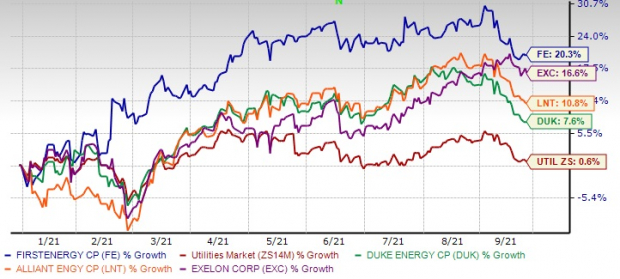4 Utilities In The Quest For Net-Zero Carbon Emission

Image: Bigstock
Electricity generation in the United States accounted for 25% of its 2019 total greenhouse emission per the United States Environmental Protection Agency release. The emissions are caused due to the usage of fossil fuel, primarily coal, to generate electricity. However, a clear transition is evident in the Utility space, with companies retiring coal-generating plants and setting up solar or other renewable facilities to make its energy emissions-free. The concerted effort of the utilities will assist in lowering greenhouse emissions.
Globally, we are experiencing the adverse impact of climate change stemming from an increase in greenhouse gas emissions in the atmosphere. Considering the urgency to reduce the impacts of climate change, 196 parties have signed the treaty —The Paris Agreement —that came into effect in 2016. The group aims to maintain the increase in the global average temperature to below 2°C and preferably to 1.5 °C compared with pre-industrial levels in the long term.
The new United States government announced plans to generate carbon-free electricity by 2035 and reach net-zero emissions by 2050. The quest of the utilities to cut down emissions will help lower the release of harmful greenhouse gas. Companies from the Zacks Utilities sector were setting targets to reduce their emissions much before the government unveiled its plans. Till April 2021, 46 U.S. utilities had pledged to go carbon-neutral by 2050. Among them are Alliant Energy (LNT Quick Quote LNT - Free Report), Exelon Corporation (EXC Quick Quote EXC - Free Report), FirstEnergy Corp. (FE Quick Quote FE - Free Report), and Duke Energy (DUK Quick Quote DUK - Free Report).
The clean energy shift is possible for the sector due to abundant availability of clean natural gas along with other alternative energy sources like solar, water, and wind. Per the U.S. Energy Information Administration release, the shares of renewables in the U.S. electricity generation mix will increase from 21% in 2020 to 42% in 2050, with wind and solar being the major contributors. Government support through Renewable Electricity Production Tax Credit and the Investment Tax Credit has augmented the usage of clean renewable energy sources in electricity generation. Investment made by the United States in clean energy totaled $85 billion in 2020, up from 2004’s figure of $10 billion, wherein the energy market played a major role.
Utilities are experimenting on the use of geothermal energy sources as an option to produce clean electricity. Nuclear energy is another clean energy generation source for utilities and is one of the largest contributors to clean energy generation in the United States.
Key Picks
We have mentioned a few stocks above that are undertaking measures to reduce carbon emissions. These firms have not only set the carbon-neutrality goal but have performed better than the Zacks Utility sector in the year-to-date period. While Exelon flaunts a Zacks Rank#1 (Strong Buy) at present, the other three stocks carry a Zacks Rank #3 (Hold).
These companies pay out regular dividends to their shareholders and have better dividend yields than the Zacks S&P 500 composite’s figure of 1.25%. Also, these stocks have better return on equity (ROE) compared with the utilities market’s figure of 4.11%. We added some more criteria for the selection of utilities from our proprietary Zacks Stock Screener.
Price Performance (Year-To-Date)

Image Source: Zacks Investment Research
Duke Energy is a diversified energy company with a wide portfolio of domestic and international, natural gas and electric as well as regulated and unregulated businesses. The company supplies delivers and processes energy in North America as well as selected international markets. During the 2021-2025 period, the company projects to spend capital worth $59 billion, which includes clean energy generation and transmission investments across Carolinas, Indiana, and Florida.
YTD Return =7.6%
Dividend Yield =4%
Long-Term Earnings Growth (three to five years) = 5.29%
Estimate Movement =The Zacks Consensus Estimate for 2021 earnings has moved 0.4% up to $5.20 in the past 60 days.
ROE =8.73%
FirstEnergy is a diversified energy company. Through its subsidiaries and affiliates, it engages in the transmission, distribution and generation of electricity. In 2021, it expects to spend up to $2.9 billion. For 2022, it anticipates an investment of up to $2.9-$3.2 billion.
YTD Return =20.3%
Dividend Yield =4.24%
Long-Term Earnings Growth (three to five years) = 4.17%
Estimate Movement =The Zacks Consensus Estimate for 2021 earnings has moved 0.4% north to $2.55 in the past 60 days.
ROE =18.17%
Exelon is a utility services holding company that operates through its subsidiaries. It has presence in every stage of the energy business— power generation, competitive energy sales, and transmission as well as delivery. The company has operations in 48 states and the District of Columbia in the United States along with Canada. It plans to invest nearly $27 billion over the 2021-2024 time frame in regulated utility operations for grid modernization and increase the resilience of its infrastructure for the benefit of customers.
YTD Return =16.6%
Dividend Yield =3.11%
Long-Term Earnings Growth (three to five years) = 2.99%
Estimate Movement =The Zacks Consensus Estimate for 2021 earnings has moved 1.1% north to $2.81 in the past 60 days.
ROE =7.42%
Alliant Energy is a holding company with subsidiaries engaged in regulated electric and natural gas services. It provides services to 975,000 electric and 420,000 natural gas customers in the Midwest. The utility plans to invest $2.2 billion in renewables during the 2021-2024 time period.
YTD Return =10.8%
Dividend Yield =2.82%
Long-Term Earnings Growth (three to five years) = 5.89%
Estimate Movement =The Zacks Consensus Estimate for 2021 earnings has moved up 0.4% to $2.59 in the past 60 days.
ROE =10.72%
Disclaimer: Neither Zacks Investment Research, Inc. nor its Information Providers can guarantee the accuracy, completeness, timeliness, or correct sequencing of any of the Information on the Web ...
more


